Operations and Project Management Report - HND Business Management
VerifiedAdded on 2023/01/12
|12
|2478
|52
Report
AI Summary
This report delves into the core principles of operations and project management, utilizing case studies of Toyota and P&P Leisure Centre to illustrate key concepts. The report examines operations management principles, including continuous improvement plans, and applies the project life cycle (PLC) to the expansion of the P&P Leisure Centre. It analyzes the effectiveness of PLC stages, such as project initiation, planning, execution, and closure, providing insights into the critical factors for project success. The analysis includes the application of various tools like the business case, project plans, work breakdown structures, critical path method, Gantt charts, and network diagrams. The report concludes by summarizing the application of these principles and providing a comprehensive overview of the effective management of operations and projects, emphasizing the importance of strategic planning and continuous improvement.
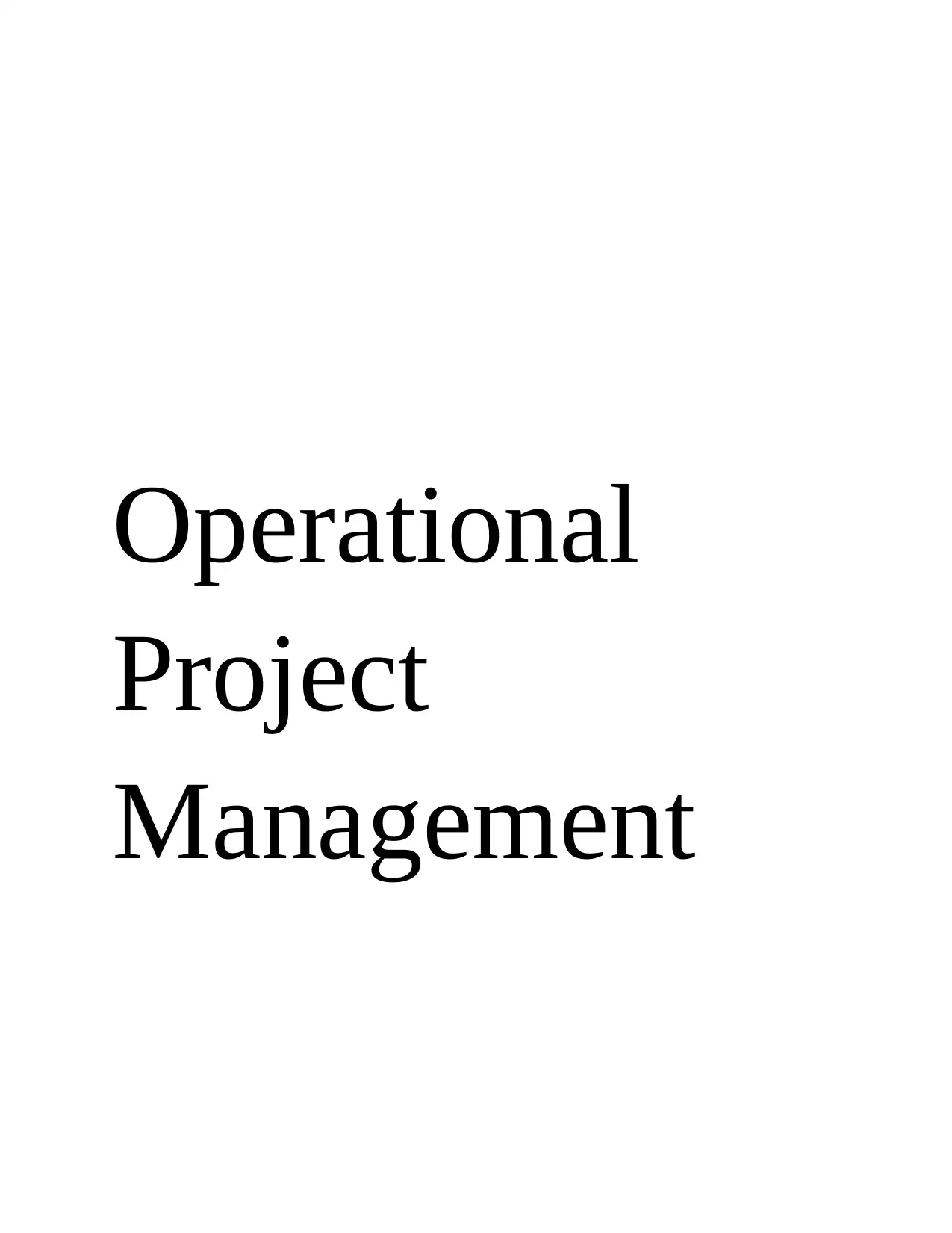
Operational
Project
Management
Project
Management
Paraphrase This Document
Need a fresh take? Get an instant paraphrase of this document with our AI Paraphraser
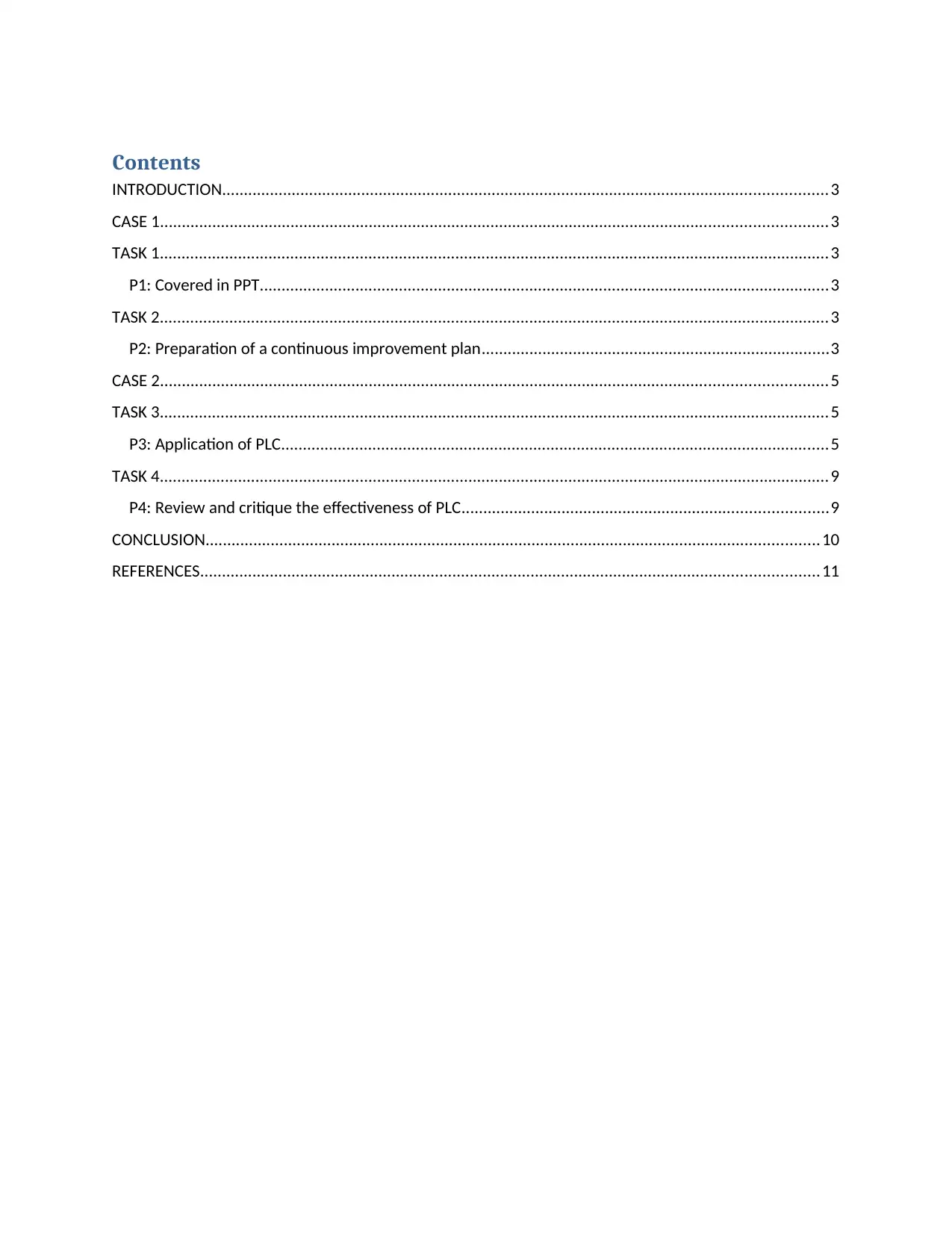
Contents
INTRODUCTION...........................................................................................................................................3
CASE 1.........................................................................................................................................................3
TASK 1..........................................................................................................................................................3
P1: Covered in PPT...................................................................................................................................3
TASK 2..........................................................................................................................................................3
P2: Preparation of a continuous improvement plan................................................................................3
CASE 2.........................................................................................................................................................5
TASK 3..........................................................................................................................................................5
P3: Application of PLC..............................................................................................................................5
TASK 4..........................................................................................................................................................9
P4: Review and critique the effectiveness of PLC....................................................................................9
CONCLUSION.............................................................................................................................................10
REFERENCES..............................................................................................................................................11
INTRODUCTION...........................................................................................................................................3
CASE 1.........................................................................................................................................................3
TASK 1..........................................................................................................................................................3
P1: Covered in PPT...................................................................................................................................3
TASK 2..........................................................................................................................................................3
P2: Preparation of a continuous improvement plan................................................................................3
CASE 2.........................................................................................................................................................5
TASK 3..........................................................................................................................................................5
P3: Application of PLC..............................................................................................................................5
TASK 4..........................................................................................................................................................9
P4: Review and critique the effectiveness of PLC....................................................................................9
CONCLUSION.............................................................................................................................................10
REFERENCES..............................................................................................................................................11
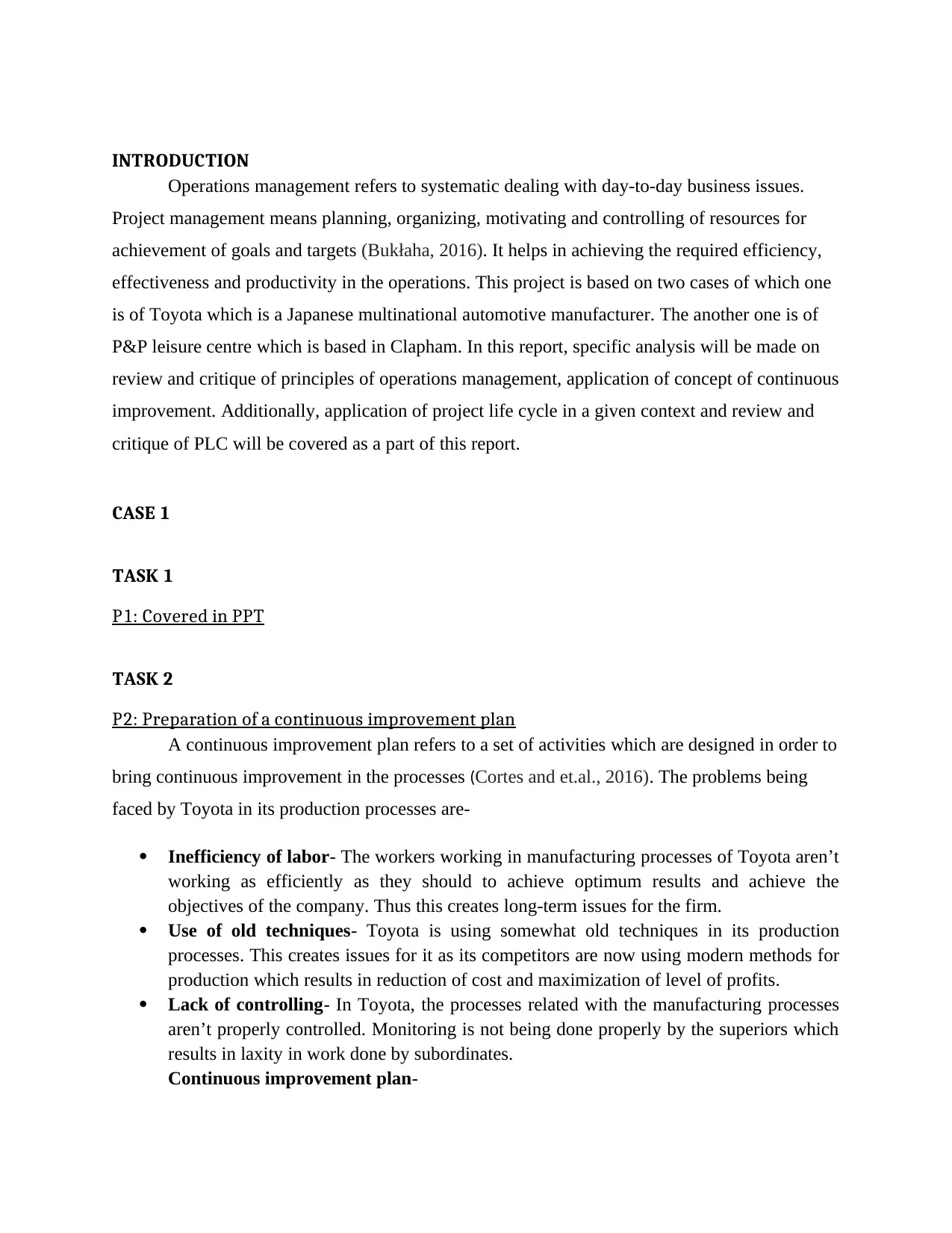
INTRODUCTION
Operations management refers to systematic dealing with day-to-day business issues.
Project management means planning, organizing, motivating and controlling of resources for
achievement of goals and targets (Bukłaha, 2016). It helps in achieving the required efficiency,
effectiveness and productivity in the operations. This project is based on two cases of which one
is of Toyota which is a Japanese multinational automotive manufacturer. The another one is of
P&P leisure centre which is based in Clapham. In this report, specific analysis will be made on
review and critique of principles of operations management, application of concept of continuous
improvement. Additionally, application of project life cycle in a given context and review and
critique of PLC will be covered as a part of this report.
CASE 1
TASK 1
P1: Covered in PPT
TASK 2
P2: Preparation of a continuous improvement plan
A continuous improvement plan refers to a set of activities which are designed in order to
bring continuous improvement in the processes (Cortes and et.al., 2016). The problems being
faced by Toyota in its production processes are-
Inefficiency of labor- The workers working in manufacturing processes of Toyota aren’t
working as efficiently as they should to achieve optimum results and achieve the
objectives of the company. Thus this creates long-term issues for the firm.
Use of old techniques- Toyota is using somewhat old techniques in its production
processes. This creates issues for it as its competitors are now using modern methods for
production which results in reduction of cost and maximization of level of profits.
Lack of controlling- In Toyota, the processes related with the manufacturing processes
aren’t properly controlled. Monitoring is not being done properly by the superiors which
results in laxity in work done by subordinates.
Continuous improvement plan-
Operations management refers to systematic dealing with day-to-day business issues.
Project management means planning, organizing, motivating and controlling of resources for
achievement of goals and targets (Bukłaha, 2016). It helps in achieving the required efficiency,
effectiveness and productivity in the operations. This project is based on two cases of which one
is of Toyota which is a Japanese multinational automotive manufacturer. The another one is of
P&P leisure centre which is based in Clapham. In this report, specific analysis will be made on
review and critique of principles of operations management, application of concept of continuous
improvement. Additionally, application of project life cycle in a given context and review and
critique of PLC will be covered as a part of this report.
CASE 1
TASK 1
P1: Covered in PPT
TASK 2
P2: Preparation of a continuous improvement plan
A continuous improvement plan refers to a set of activities which are designed in order to
bring continuous improvement in the processes (Cortes and et.al., 2016). The problems being
faced by Toyota in its production processes are-
Inefficiency of labor- The workers working in manufacturing processes of Toyota aren’t
working as efficiently as they should to achieve optimum results and achieve the
objectives of the company. Thus this creates long-term issues for the firm.
Use of old techniques- Toyota is using somewhat old techniques in its production
processes. This creates issues for it as its competitors are now using modern methods for
production which results in reduction of cost and maximization of level of profits.
Lack of controlling- In Toyota, the processes related with the manufacturing processes
aren’t properly controlled. Monitoring is not being done properly by the superiors which
results in laxity in work done by subordinates.
Continuous improvement plan-
⊘ This is a preview!⊘
Do you want full access?
Subscribe today to unlock all pages.

Trusted by 1+ million students worldwide

A continuous improvement plan will be used by Toyota to bring efficiency and
effectiveness in its functioning and manufacturing processes. The plan which it will use is
explained as under-
Training sessions for labor-
Resources required- This objective of continuous improvement plan will require
use of extensive resources and funds such as arrangement of special training sessions for the
labor to address their concerns and to make them aware about bringing productivity in their work
(Davies and Brady, 2016).
Timescale for review- In every 3 months this objective will be reviewed.
Result of review- On review it was found that after attending these special
sessions the productivity, efficiency and effectiveness of labor has improved. They are now
working optimally to produce the required results.
Use of new techniques for production-
Resources required- A new technique of production has to be identified for
achievement of this objective. Furthermore, heavy investment in new technology for
manufacturing may have to be done by the company (Kivilä, Martinsuo and Vuorinen, 2017).
Timescale for review- It has to be review in every 6 months for ensuring its
effectiveness.
Result of review- On reviewing, it was found out that using these new techniques
for production will result in cost savings and ultimately will lead towards increased profitability.
Use of computerized monitoring software-
Resources required- The resources required for it would be a computerized
system in which there is monitoring and tracking software which may be used for identifying the
progress of work which has to be done.
Timescale for review- It has to be reviewed in every 1 month to ensure optimum
results.
Result of review- On review, it was found out that use of computerized system
with monitoring and tracking software has resulted in quick identification of deviations and
variances. Thus rectifying measures to reduce them can be taken in time to ensure smoothness of
operations in the firm. Also labor’s activities are being effectively monitored by the superiors to
effectiveness in its functioning and manufacturing processes. The plan which it will use is
explained as under-
Training sessions for labor-
Resources required- This objective of continuous improvement plan will require
use of extensive resources and funds such as arrangement of special training sessions for the
labor to address their concerns and to make them aware about bringing productivity in their work
(Davies and Brady, 2016).
Timescale for review- In every 3 months this objective will be reviewed.
Result of review- On review it was found that after attending these special
sessions the productivity, efficiency and effectiveness of labor has improved. They are now
working optimally to produce the required results.
Use of new techniques for production-
Resources required- A new technique of production has to be identified for
achievement of this objective. Furthermore, heavy investment in new technology for
manufacturing may have to be done by the company (Kivilä, Martinsuo and Vuorinen, 2017).
Timescale for review- It has to be review in every 6 months for ensuring its
effectiveness.
Result of review- On reviewing, it was found out that using these new techniques
for production will result in cost savings and ultimately will lead towards increased profitability.
Use of computerized monitoring software-
Resources required- The resources required for it would be a computerized
system in which there is monitoring and tracking software which may be used for identifying the
progress of work which has to be done.
Timescale for review- It has to be reviewed in every 1 month to ensure optimum
results.
Result of review- On review, it was found out that use of computerized system
with monitoring and tracking software has resulted in quick identification of deviations and
variances. Thus rectifying measures to reduce them can be taken in time to ensure smoothness of
operations in the firm. Also labor’s activities are being effectively monitored by the superiors to
Paraphrase This Document
Need a fresh take? Get an instant paraphrase of this document with our AI Paraphraser
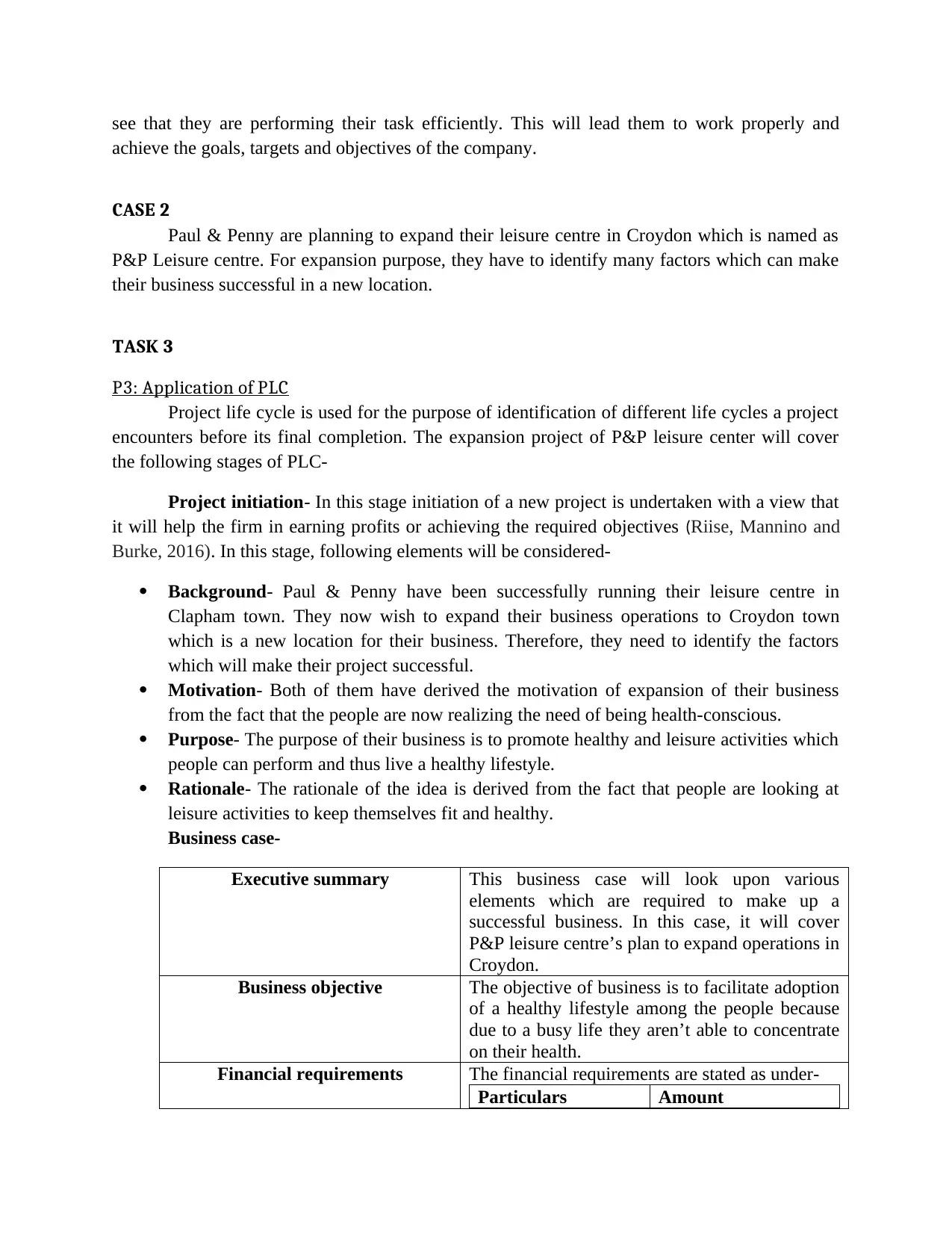
see that they are performing their task efficiently. This will lead them to work properly and
achieve the goals, targets and objectives of the company.
CASE 2
Paul & Penny are planning to expand their leisure centre in Croydon which is named as
P&P Leisure centre. For expansion purpose, they have to identify many factors which can make
their business successful in a new location.
TASK 3
P3: Application of PLC
Project life cycle is used for the purpose of identification of different life cycles a project
encounters before its final completion. The expansion project of P&P leisure center will cover
the following stages of PLC-
Project initiation- In this stage initiation of a new project is undertaken with a view that
it will help the firm in earning profits or achieving the required objectives (Riise, Mannino and
Burke, 2016). In this stage, following elements will be considered-
Background- Paul & Penny have been successfully running their leisure centre in
Clapham town. They now wish to expand their business operations to Croydon town
which is a new location for their business. Therefore, they need to identify the factors
which will make their project successful.
Motivation- Both of them have derived the motivation of expansion of their business
from the fact that the people are now realizing the need of being health-conscious.
Purpose- The purpose of their business is to promote healthy and leisure activities which
people can perform and thus live a healthy lifestyle.
Rationale- The rationale of the idea is derived from the fact that people are looking at
leisure activities to keep themselves fit and healthy.
Business case-
Executive summary This business case will look upon various
elements which are required to make up a
successful business. In this case, it will cover
P&P leisure centre’s plan to expand operations in
Croydon.
Business objective The objective of business is to facilitate adoption
of a healthy lifestyle among the people because
due to a busy life they aren’t able to concentrate
on their health.
Financial requirements The financial requirements are stated as under-
Particulars Amount
achieve the goals, targets and objectives of the company.
CASE 2
Paul & Penny are planning to expand their leisure centre in Croydon which is named as
P&P Leisure centre. For expansion purpose, they have to identify many factors which can make
their business successful in a new location.
TASK 3
P3: Application of PLC
Project life cycle is used for the purpose of identification of different life cycles a project
encounters before its final completion. The expansion project of P&P leisure center will cover
the following stages of PLC-
Project initiation- In this stage initiation of a new project is undertaken with a view that
it will help the firm in earning profits or achieving the required objectives (Riise, Mannino and
Burke, 2016). In this stage, following elements will be considered-
Background- Paul & Penny have been successfully running their leisure centre in
Clapham town. They now wish to expand their business operations to Croydon town
which is a new location for their business. Therefore, they need to identify the factors
which will make their project successful.
Motivation- Both of them have derived the motivation of expansion of their business
from the fact that the people are now realizing the need of being health-conscious.
Purpose- The purpose of their business is to promote healthy and leisure activities which
people can perform and thus live a healthy lifestyle.
Rationale- The rationale of the idea is derived from the fact that people are looking at
leisure activities to keep themselves fit and healthy.
Business case-
Executive summary This business case will look upon various
elements which are required to make up a
successful business. In this case, it will cover
P&P leisure centre’s plan to expand operations in
Croydon.
Business objective The objective of business is to facilitate adoption
of a healthy lifestyle among the people because
due to a busy life they aren’t able to concentrate
on their health.
Financial requirements The financial requirements are stated as under-
Particulars Amount
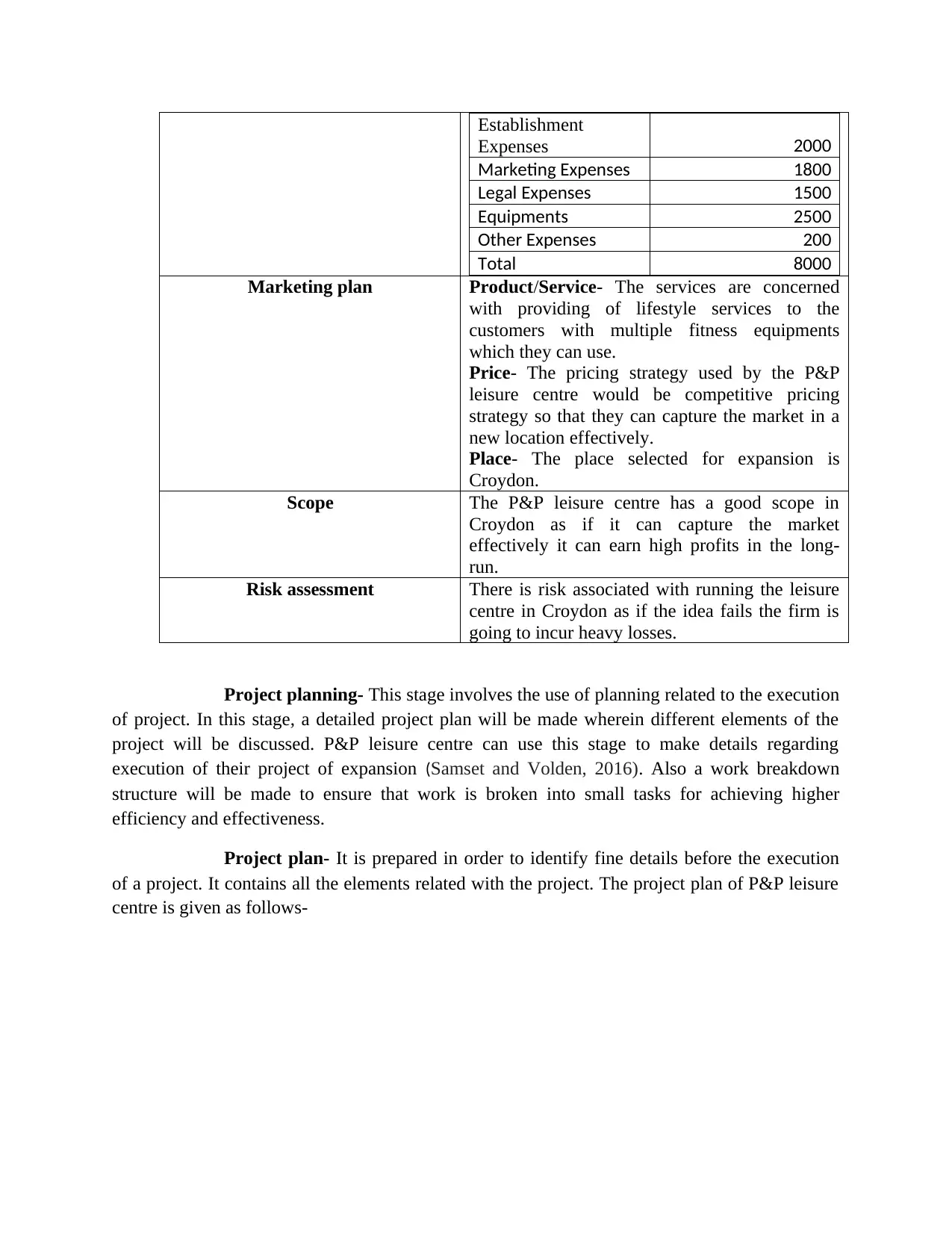
Establishment
Expenses 2000
Marketing Expenses 1800
Legal Expenses 1500
Equipments 2500
Other Expenses 200
Total 8000
Marketing plan Product/Service- The services are concerned
with providing of lifestyle services to the
customers with multiple fitness equipments
which they can use.
Price- The pricing strategy used by the P&P
leisure centre would be competitive pricing
strategy so that they can capture the market in a
new location effectively.
Place- The place selected for expansion is
Croydon.
Scope The P&P leisure centre has a good scope in
Croydon as if it can capture the market
effectively it can earn high profits in the long-
run.
Risk assessment There is risk associated with running the leisure
centre in Croydon as if the idea fails the firm is
going to incur heavy losses.
Project planning- This stage involves the use of planning related to the execution
of project. In this stage, a detailed project plan will be made wherein different elements of the
project will be discussed. P&P leisure centre can use this stage to make details regarding
execution of their project of expansion (Samset and Volden, 2016). Also a work breakdown
structure will be made to ensure that work is broken into small tasks for achieving higher
efficiency and effectiveness.
Project plan- It is prepared in order to identify fine details before the execution
of a project. It contains all the elements related with the project. The project plan of P&P leisure
centre is given as follows-
Expenses 2000
Marketing Expenses 1800
Legal Expenses 1500
Equipments 2500
Other Expenses 200
Total 8000
Marketing plan Product/Service- The services are concerned
with providing of lifestyle services to the
customers with multiple fitness equipments
which they can use.
Price- The pricing strategy used by the P&P
leisure centre would be competitive pricing
strategy so that they can capture the market in a
new location effectively.
Place- The place selected for expansion is
Croydon.
Scope The P&P leisure centre has a good scope in
Croydon as if it can capture the market
effectively it can earn high profits in the long-
run.
Risk assessment There is risk associated with running the leisure
centre in Croydon as if the idea fails the firm is
going to incur heavy losses.
Project planning- This stage involves the use of planning related to the execution
of project. In this stage, a detailed project plan will be made wherein different elements of the
project will be discussed. P&P leisure centre can use this stage to make details regarding
execution of their project of expansion (Samset and Volden, 2016). Also a work breakdown
structure will be made to ensure that work is broken into small tasks for achieving higher
efficiency and effectiveness.
Project plan- It is prepared in order to identify fine details before the execution
of a project. It contains all the elements related with the project. The project plan of P&P leisure
centre is given as follows-
⊘ This is a preview!⊘
Do you want full access?
Subscribe today to unlock all pages.

Trusted by 1+ million students worldwide

Work breakdown structure- It is used to break the work into various types of
small tasks. It is essential in order to ensure that tasks are allotted to different people working in
an organization according to their capabilities. The detailed work breakdown structure of P&P
leisure center is as follows-
small tasks. It is essential in order to ensure that tasks are allotted to different people working in
an organization according to their capabilities. The detailed work breakdown structure of P&P
leisure center is as follows-
Paraphrase This Document
Need a fresh take? Get an instant paraphrase of this document with our AI Paraphraser
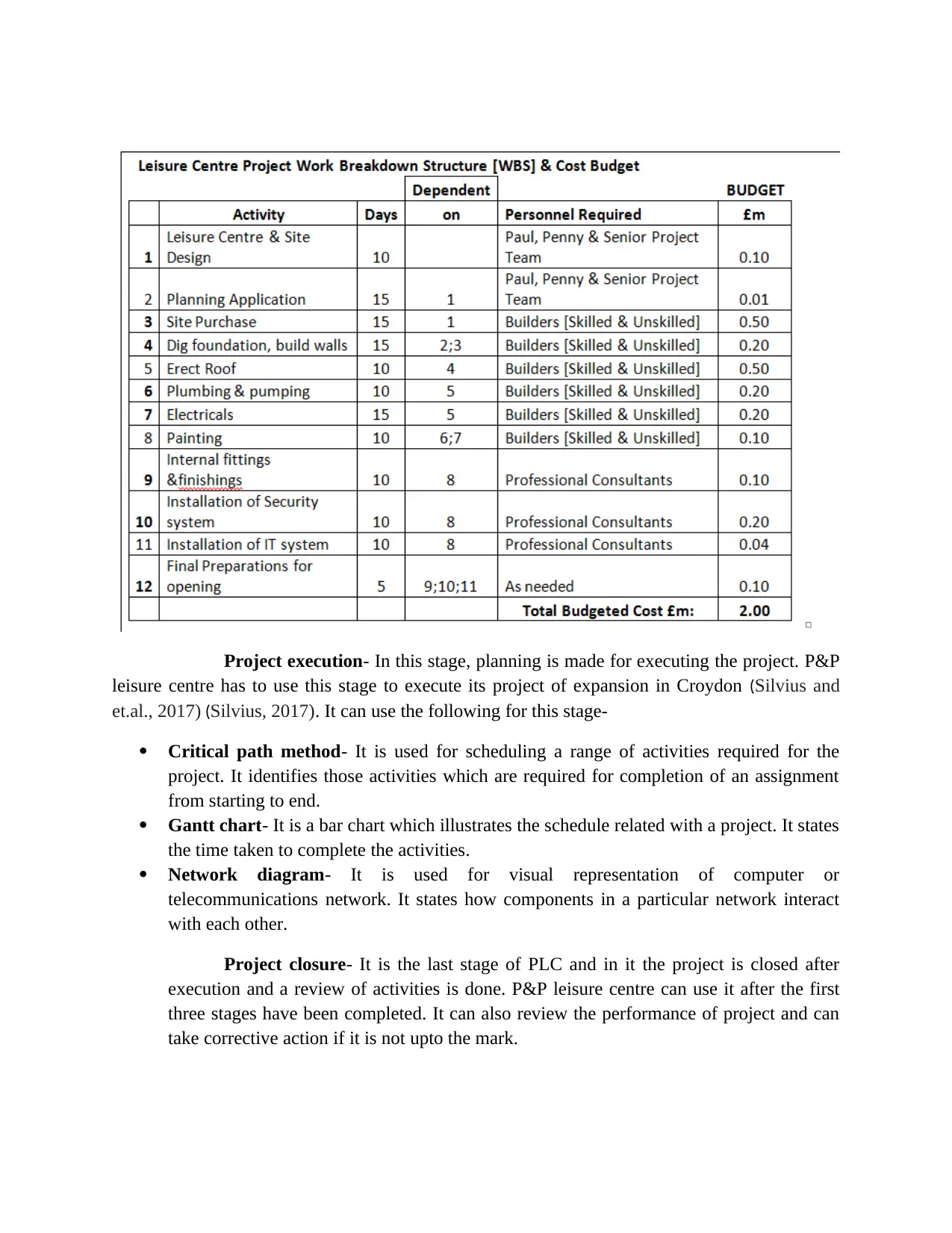
Project execution- In this stage, planning is made for executing the project. P&P
leisure centre has to use this stage to execute its project of expansion in Croydon (Silvius and
et.al., 2017) (Silvius, 2017). It can use the following for this stage-
Critical path method- It is used for scheduling a range of activities required for the
project. It identifies those activities which are required for completion of an assignment
from starting to end.
Gantt chart- It is a bar chart which illustrates the schedule related with a project. It states
the time taken to complete the activities.
Network diagram- It is used for visual representation of computer or
telecommunications network. It states how components in a particular network interact
with each other.
Project closure- It is the last stage of PLC and in it the project is closed after
execution and a review of activities is done. P&P leisure centre can use it after the first
three stages have been completed. It can also review the performance of project and can
take corrective action if it is not upto the mark.
leisure centre has to use this stage to execute its project of expansion in Croydon (Silvius and
et.al., 2017) (Silvius, 2017). It can use the following for this stage-
Critical path method- It is used for scheduling a range of activities required for the
project. It identifies those activities which are required for completion of an assignment
from starting to end.
Gantt chart- It is a bar chart which illustrates the schedule related with a project. It states
the time taken to complete the activities.
Network diagram- It is used for visual representation of computer or
telecommunications network. It states how components in a particular network interact
with each other.
Project closure- It is the last stage of PLC and in it the project is closed after
execution and a review of activities is done. P&P leisure centre can use it after the first
three stages have been completed. It can also review the performance of project and can
take corrective action if it is not upto the mark.
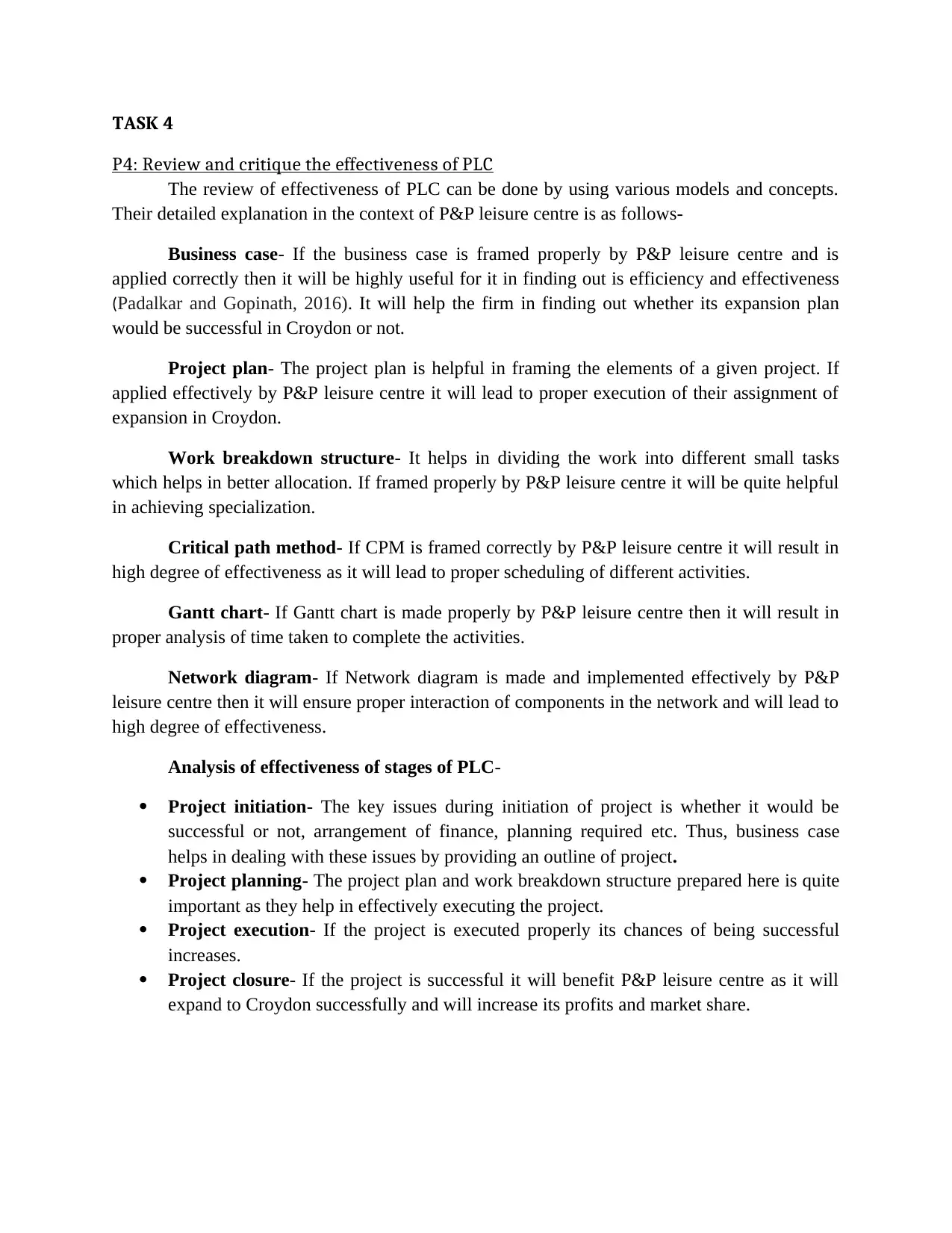
TASK 4
P4: Review and critique the effectiveness of PLC
The review of effectiveness of PLC can be done by using various models and concepts.
Their detailed explanation in the context of P&P leisure centre is as follows-
Business case- If the business case is framed properly by P&P leisure centre and is
applied correctly then it will be highly useful for it in finding out is efficiency and effectiveness
(Padalkar and Gopinath, 2016). It will help the firm in finding out whether its expansion plan
would be successful in Croydon or not.
Project plan- The project plan is helpful in framing the elements of a given project. If
applied effectively by P&P leisure centre it will lead to proper execution of their assignment of
expansion in Croydon.
Work breakdown structure- It helps in dividing the work into different small tasks
which helps in better allocation. If framed properly by P&P leisure centre it will be quite helpful
in achieving specialization.
Critical path method- If CPM is framed correctly by P&P leisure centre it will result in
high degree of effectiveness as it will lead to proper scheduling of different activities.
Gantt chart- If Gantt chart is made properly by P&P leisure centre then it will result in
proper analysis of time taken to complete the activities.
Network diagram- If Network diagram is made and implemented effectively by P&P
leisure centre then it will ensure proper interaction of components in the network and will lead to
high degree of effectiveness.
Analysis of effectiveness of stages of PLC-
Project initiation- The key issues during initiation of project is whether it would be
successful or not, arrangement of finance, planning required etc. Thus, business case
helps in dealing with these issues by providing an outline of project.
Project planning- The project plan and work breakdown structure prepared here is quite
important as they help in effectively executing the project.
Project execution- If the project is executed properly its chances of being successful
increases.
Project closure- If the project is successful it will benefit P&P leisure centre as it will
expand to Croydon successfully and will increase its profits and market share.
P4: Review and critique the effectiveness of PLC
The review of effectiveness of PLC can be done by using various models and concepts.
Their detailed explanation in the context of P&P leisure centre is as follows-
Business case- If the business case is framed properly by P&P leisure centre and is
applied correctly then it will be highly useful for it in finding out is efficiency and effectiveness
(Padalkar and Gopinath, 2016). It will help the firm in finding out whether its expansion plan
would be successful in Croydon or not.
Project plan- The project plan is helpful in framing the elements of a given project. If
applied effectively by P&P leisure centre it will lead to proper execution of their assignment of
expansion in Croydon.
Work breakdown structure- It helps in dividing the work into different small tasks
which helps in better allocation. If framed properly by P&P leisure centre it will be quite helpful
in achieving specialization.
Critical path method- If CPM is framed correctly by P&P leisure centre it will result in
high degree of effectiveness as it will lead to proper scheduling of different activities.
Gantt chart- If Gantt chart is made properly by P&P leisure centre then it will result in
proper analysis of time taken to complete the activities.
Network diagram- If Network diagram is made and implemented effectively by P&P
leisure centre then it will ensure proper interaction of components in the network and will lead to
high degree of effectiveness.
Analysis of effectiveness of stages of PLC-
Project initiation- The key issues during initiation of project is whether it would be
successful or not, arrangement of finance, planning required etc. Thus, business case
helps in dealing with these issues by providing an outline of project.
Project planning- The project plan and work breakdown structure prepared here is quite
important as they help in effectively executing the project.
Project execution- If the project is executed properly its chances of being successful
increases.
Project closure- If the project is successful it will benefit P&P leisure centre as it will
expand to Croydon successfully and will increase its profits and market share.
⊘ This is a preview!⊘
Do you want full access?
Subscribe today to unlock all pages.

Trusted by 1+ million students worldwide

CONCLUSION
From the above report, it can be concluded that operation and project management is a
process of successfully managing the operations of a company using different techniques for
efficiency and effectiveness. Operation management principles like six sigma and lean
principles can be used for finding efficiency of processes. Continuous improvement plan can be
made in order to bring improvements in processes. Stages of PLC can be applied for ensuring
successful execution of project. Review of PLC can be done to ensure its effectiveness.
From the above report, it can be concluded that operation and project management is a
process of successfully managing the operations of a company using different techniques for
efficiency and effectiveness. Operation management principles like six sigma and lean
principles can be used for finding efficiency of processes. Continuous improvement plan can be
made in order to bring improvements in processes. Stages of PLC can be applied for ensuring
successful execution of project. Review of PLC can be done to ensure its effectiveness.
Paraphrase This Document
Need a fresh take? Get an instant paraphrase of this document with our AI Paraphraser
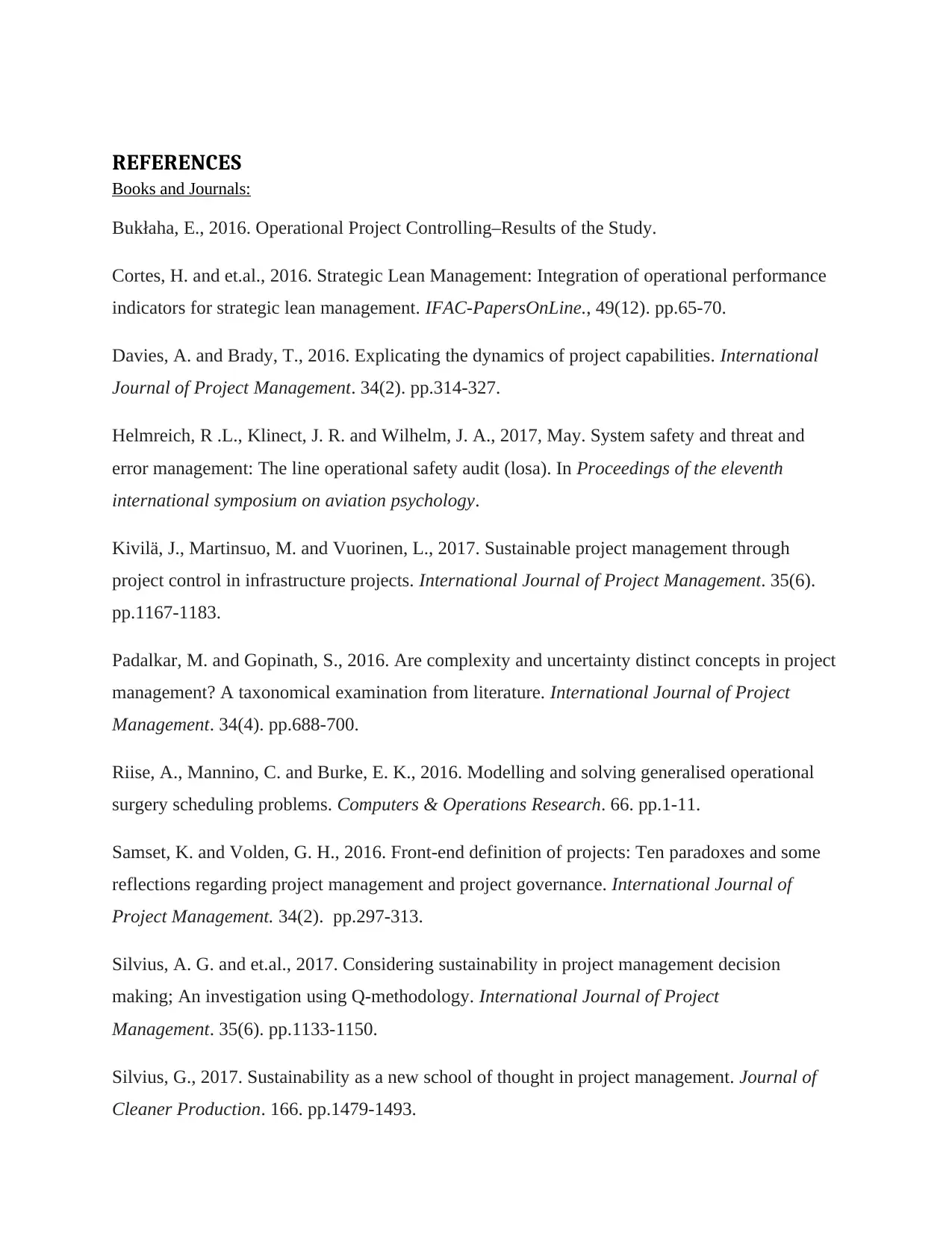
REFERENCES
Books and Journals:
Bukłaha, E., 2016. Operational Project Controlling–Results of the Study.
Cortes, H. and et.al., 2016. Strategic Lean Management: Integration of operational performance
indicators for strategic lean management. IFAC-PapersOnLine., 49(12). pp.65-70.
Davies, A. and Brady, T., 2016. Explicating the dynamics of project capabilities. International
Journal of Project Management. 34(2). pp.314-327.
Helmreich, R .L., Klinect, J. R. and Wilhelm, J. A., 2017, May. System safety and threat and
error management: The line operational safety audit (losa). In Proceedings of the eleventh
international symposium on aviation psychology.
Kivilä, J., Martinsuo, M. and Vuorinen, L., 2017. Sustainable project management through
project control in infrastructure projects. International Journal of Project Management. 35(6).
pp.1167-1183.
Padalkar, M. and Gopinath, S., 2016. Are complexity and uncertainty distinct concepts in project
management? A taxonomical examination from literature. International Journal of Project
Management. 34(4). pp.688-700.
Riise, A., Mannino, C. and Burke, E. K., 2016. Modelling and solving generalised operational
surgery scheduling problems. Computers & Operations Research. 66. pp.1-11.
Samset, K. and Volden, G. H., 2016. Front-end definition of projects: Ten paradoxes and some
reflections regarding project management and project governance. International Journal of
Project Management. 34(2). pp.297-313.
Silvius, A. G. and et.al., 2017. Considering sustainability in project management decision
making; An investigation using Q-methodology. International Journal of Project
Management. 35(6). pp.1133-1150.
Silvius, G., 2017. Sustainability as a new school of thought in project management. Journal of
Cleaner Production. 166. pp.1479-1493.
Books and Journals:
Bukłaha, E., 2016. Operational Project Controlling–Results of the Study.
Cortes, H. and et.al., 2016. Strategic Lean Management: Integration of operational performance
indicators for strategic lean management. IFAC-PapersOnLine., 49(12). pp.65-70.
Davies, A. and Brady, T., 2016. Explicating the dynamics of project capabilities. International
Journal of Project Management. 34(2). pp.314-327.
Helmreich, R .L., Klinect, J. R. and Wilhelm, J. A., 2017, May. System safety and threat and
error management: The line operational safety audit (losa). In Proceedings of the eleventh
international symposium on aviation psychology.
Kivilä, J., Martinsuo, M. and Vuorinen, L., 2017. Sustainable project management through
project control in infrastructure projects. International Journal of Project Management. 35(6).
pp.1167-1183.
Padalkar, M. and Gopinath, S., 2016. Are complexity and uncertainty distinct concepts in project
management? A taxonomical examination from literature. International Journal of Project
Management. 34(4). pp.688-700.
Riise, A., Mannino, C. and Burke, E. K., 2016. Modelling and solving generalised operational
surgery scheduling problems. Computers & Operations Research. 66. pp.1-11.
Samset, K. and Volden, G. H., 2016. Front-end definition of projects: Ten paradoxes and some
reflections regarding project management and project governance. International Journal of
Project Management. 34(2). pp.297-313.
Silvius, A. G. and et.al., 2017. Considering sustainability in project management decision
making; An investigation using Q-methodology. International Journal of Project
Management. 35(6). pp.1133-1150.
Silvius, G., 2017. Sustainability as a new school of thought in project management. Journal of
Cleaner Production. 166. pp.1479-1493.

⊘ This is a preview!⊘
Do you want full access?
Subscribe today to unlock all pages.

Trusted by 1+ million students worldwide
1 out of 12
Related Documents
Your All-in-One AI-Powered Toolkit for Academic Success.
+13062052269
info@desklib.com
Available 24*7 on WhatsApp / Email
![[object Object]](/_next/static/media/star-bottom.7253800d.svg)
Unlock your academic potential
Copyright © 2020–2025 A2Z Services. All Rights Reserved. Developed and managed by ZUCOL.





